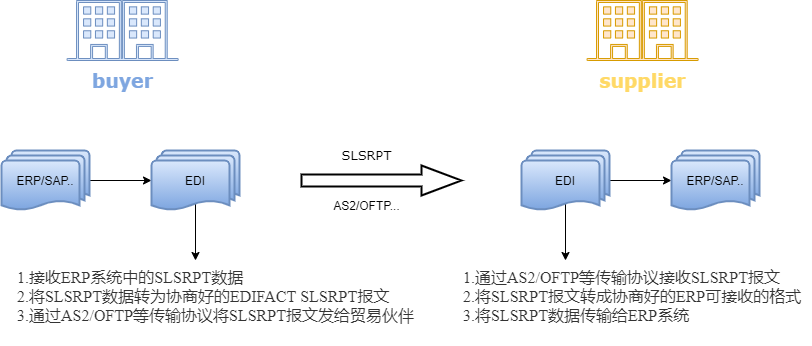This paper provides the definition and specification of SLSRPT sales report under the UN/EDIFACT (electronic data interchange for administrative, commercial and transportation industries) standard, which is widely used in Europe, Oceania and some Asian countries.
UN/EDIFACT SLSRPT: Sales Report Message
UN/EDIFACT SLSRPT sales report is used to electronically send messages related to product or service sales to trading partners, including: identifier of specific product, sales location, sales price, quantity, sales time, turnover in a specified time period, total sales of product location, participants, etc. and other sales related data information.
This message contains the sales data of one or more locations in a specified period, which is usually used by buyers to send to their suppliers. This information can be counted and analyzed by trading partners to support the adjustment of their production, replenishment, planning and other modules.
SLSRPT sales report is based on common practices related to administration, commerce and transportation, does not depend on the type of enterprise or industry, and can be applied domestically and internationally.
Common cases - intermediate database scheme
SLSRPT data is generally generated through the buyer's ERP system (or other management system), then converted into a specific EDIFACT SLSRPT version negotiated with the trading partner, and finally sent to the trading partner through EDI transmission protocol. These data will affect the receiver's future production and plan, as shown in the figure below:

EDI process of SLSRPT sending direction: firstly, sort out the data Mapping table Mapping according to the specification (the Mapping includes the SLSRPT related business fields, business structure and other information under the specification). After verification, build the intermediate database table according to the Mapping, then ERP writes the SLSRPT data into the intermediate database, and EDI exports the SLSRPT data from the intermediate database, Finally, it is converted into the SLSRPT message format that can be received by the trading partner and transmitted to the trading partner through the agreed transmission protocol (AS2/OFTP...).
EDI process of SLSRPT receiving direction: sort out mapping according to the specification and build an intermediate database table. EDI receives SLSRPT messages from trading partners through the agreed transmission protocol (AS2/OFTP...), converts and extracts SLSRPT data and writes it into the intermediate database. ERP system reads the data from the intermediate database and displays it on the interface.
In addition to the intermediate database scheme, you can also select Excel, CSV, API call and other schemes according to the actual situation to safely, accurately and quickly transmit the data of SLSRPT sales report.
EDI SLSRPT example message
For the following example message, the details of SLSRPT specification provided by different companies will be different, and the specific situation shall prevail.
UNB+UNOA:1+SENDERID:ZZ+ RECEIVEID:ZZ +210212:1534+174++SLSRPT' // Message header, including sender and receiver, date and other information‘ SENDERID 'and' RECEIVEID 'denote sender and receiver IDs UNH+6+SLSRPT:D:97A:UN:EDSR01' // The message header contains information such as business type BGM+RES+123456789+9' // Business primary key, including sales report number and other information, '123456789' represents the unique number of the sales report DTM+137:20210208:102' // Date information, 137 refers to the document creation date, that is, the document creation date is 20210208 NAD+BY+456789::91++BYER NAME++CITY++12345+DE' // NAD segment is participant information; By buyer, including the buyer's ID, name, city, postal code and other information NAD+DP+456987::91++SHIP TO NAME++CITY++12345+DE' // DP - ship to Party CUX+2:EUR:4' // CUX contains currency code information, 'EUR' is currency code DOC+380' // DOC stores currency details and 380 refers to invoices NAD+PC+987456::92++END NAME++CITY++12345+DE' // PC actual purchaser's customer LIN+1+31+VPITEM1:VP::91' // Material details, '1' is the material line number; VP - Vendor's (seller's) part number,Supplier (seller) material No therefore'VPITEM1'Item no. of supplier (seller) PIA+1+BPITEM1:BP::92' // PIA contains the purchaser's material number information, BP - Buyer's part number, seller's material number. QTY+1:100:PCE' // The QTY field contains the relevant quantity information of the corresponding material PRI+AAA:345.650:CA::1:PCE' // The PRI section contains the price information related to the corresponding material RFF+DM:0654239:10' // REF is the reference segment, DM - Document number (invoice), so '0654239' is the invoice number DTM+171:20210608:102' // 171 refers to the invoice creation date UNT+110+6' UNZ+24+278'
Benefits of using EDIFACT SLSRPT
1. Automatic EDI replaces manual upload, reduces manual input error, and data can arrive at customers quickly and accurately
2. Reduce duplication of labor, improve work efficiency and reduce labor cost
3. The buyer can timely provide the sales information to the supplier so that the supplier can adjust the future supply plan, improve the accuracy of all plans and forecasts, and simplify the trade process
Note: some pictures and contents of the copy come from the Internet, and the copyright belongs to the original author. If your rights and interests are infringed, please contact us to delete them. We are deeply sorry for the trouble caused to you.